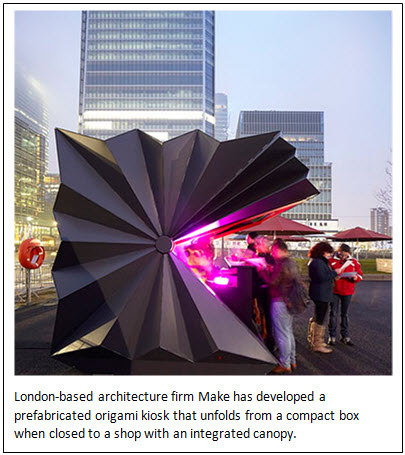Into the Fold: How Origami is Helping to Solve Manufacturing Challenges
Blog: Apriso Blog
 To the vast majority of people, origami is a hobby – a way of folding paper to create objects that have little value beyond their aesthetic qualities. But Manu Prakash, an assistant professor of bioengineering at Stanford University in California, is using the art form to create something with the potential to save millions of lives.
To the vast majority of people, origami is a hobby – a way of folding paper to create objects that have little value beyond their aesthetic qualities. But Manu Prakash, an assistant professor of bioengineering at Stanford University in California, is using the art form to create something with the potential to save millions of lives.
Prakash’s brainchild is the Foldscope – a powerful working microscope that can be used to detect blood-borne diseases like malaria and sleeping sickness. It can be assembled from a flat sheet of paper; costing just US 50 cents to manufacture, Foldscope has the potential to revolutionize health care in developing countries.
Prakash is not alone in solving complex challenges with origami. Joe Gattas, a civil engineer and lecturer at the University of Queensland in Australia, has also leveraged origami in his Plate House concept – a folded shell structural system that, in the future, could be used by the UN High Commissioner for Refugees (UNHCR), to house displaced people. Origami offers inherent structural strength and thermal insulation, and can be assembled without tools or connection components.
Kristina Wissling, an origami artist based in Germany, says that origami brings unique properties to construction. “Folding is used to achieve an increase in stiffness at minimal expense of weight,” she said. “These principles can also be applied in the design of lightweight sandwichpanel cores for aircraft fuselages.”
Robert Lang, who gave up a career as a physicist and mathematician with NASA’s Jet Propulsion Laboratory in Pasadena, California, to devote his time to origami engineering projects, is collaborating with Brian Trease, a mechanical engineer at NASA’s Jet Propulsion Laboratory, to create a solar array that could power future space missions. “The solar arrays fixed on the International Space Station currently provide around 84 kilowatts of power,” Trease said. “But this took a number of different space launches and spacewalks to install – equating to a huge investment in terms of money and manpower.”
Trease’s prototype looks like a flower when it unfolds from a 2.7-meter (8.8-foot) package, blooming into a flat, circular surface the size of three tennis courts. “Using origami folds is a novel way of doing things, but it works perfectly,” Trease said. “The result is that we could double the current power of the Space Station, but with only a single launch vehicle and a single array deployment.”
Growing Success
Origami’s expandability translates to many other applications – and to a variety of industries. For example, Stavros Georgakopoulos, an associate professor in the Department of Electrical and Computer Engineering at Florida International University, Miami, has a US$2 million grant from the National Science Foundation to create an origami antenna.
“Traditional antennas are large and often clumsy to transport,” Georgakopoulos said. “But these problems are solved with origami antennas. Commercial applications could include many types of communication equipment like satellite phones. They could also be used in wireless sensors, health monitoring sensors, portable medical equipment and more.”
Meanwhile, a British-Japanese duo from the Engineering Science Department at Oxford University in the UK – Zhong You (Professor of Engineering Science in the Department of Engineering Science) and Kaori Kuribayashi-Shigetomi (now a project assistant professor in the Graduate School of Health Sciences at Hokkaido University in Japan) – have used origami to create a prototype heart stent that can be reduced to just 12 mm (0.47 inches).
The stent, which was produced in bioplastic, can be threaded into a blood vessel, maneuvered into position in a blocked artery, and then opened to 23 mm (0.9 inches) to prop open the artery and restore blood flow. The team has also developed a technique they call “cell origami,” which uses folding to create 3D cell-laden microstructures that can be used for fabricating artificial tissues in hollow shapes to create biohybrid medical devices such as stents and grafts from human cells.
This blog post is an extract from a full article, which was reprinted with permission from Compass Magazine, “Strategic Marketing in the Age of Experience,” Issue #7 – 2015, published by Dassault Systèmes.
If you liked this article, here are others you might also find interesting:
- Packaging Innovation for the 21st Century
- Manufacturing as a Service
- Simulating Success in the Automotive Manufacturing Industries
Leave a Comment
You must be logged in to post a comment.







